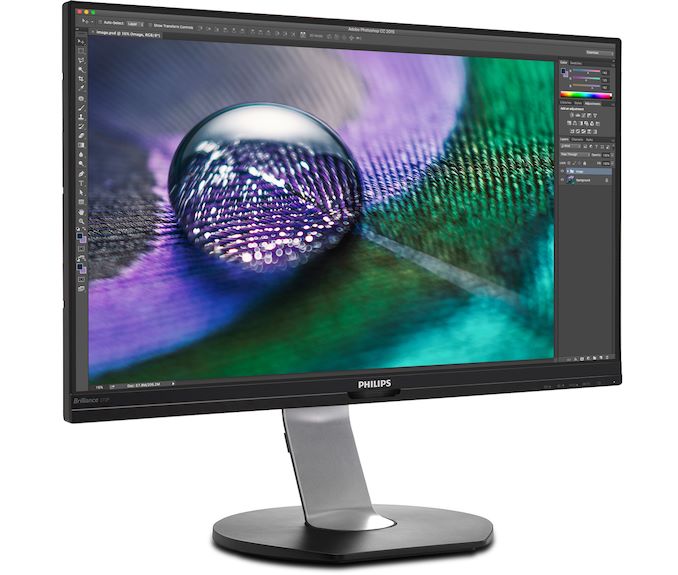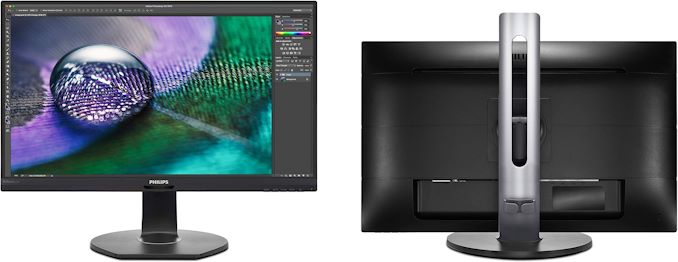Philips Brilliance 272P7VUBNB: A Sub-$350 27-Inch 4K IPS Monitor with 65W USB PD & GbE
by Anton Shilov on October 24, 2019 11:00 AM EST
In previous years monitor capabilities such as 4K resolutions, USB-C docking, and GbE connectivity have been premium features that have only been available in high-end monitors. However the price of all of those technologies is continuing to come down, and as such, those features are filtering down to increasingly mainstream monitors. To that end, Philips is launching its Brilliance 272P7VUBNB 4K display, a moderately priced 27-inch monitor with a USB 3.2 Gen 2 Type-C connector, a GbE port, and a PowerSensor that reduces its brightness when no user is present.
Designed primarily for office and productivity workloads, the Philips Brilliance 272P7VUBNB monitor uses a 27-inch IPS panel with a 3840×2160 resolution, 350 nits brightness, a 1000:1 contrast ratio, 178°/178° horizontal/vertical viewing angles, a 5 ms GtG response time, and a 60 Hz refresh rate. Since the LCD is not aimed at gamers or multimedia enthusiasts, it does not support a variable refresh rate technology and is not meant for HDR content. Nonetheless, it comes factory calibrated with a Delta E <2 accuracy, can display 1.07 billion colors, and reproduce 122% of the sRGB color gamut as well as 103% of the NTSC color gamut. Moreover, the panel has an 3H anti-glare coating, something that is valuable in office monitors.
The Brilliance 272P7VUBNB monitor comes equipped with a GbE port to provide Ethernet connectivity to laptops that do not have an appropriate adapter built-in. Since the GbE port is fed via USB, Phillips has decided to double-down on USB altogether, offering a USB-C input to connect upstream to a host machine and provide single-cable funcitonality. The display’s USB-C port can deliver up to 65 W of power to the host, which is enough for the majority of 13.3-inch and 14-inch mobile PCs. The USB upstream port is also used to feed a dual-port USB 3.2 Type-A hub.
Otherwise, a DisplayPort 1.2 input and an HDMI 2.0 port are also available so that the monitor can be used with older devices. The monitor also offers a headphone output, but no integrated speakers
Traditionally for Philips' P-series monitors, the Brilliance 272P7VUBNB comes equipped with the company's SmartErgoBase stand that can regulate height, tilt, swivel, and can enable both landscape and portrait modes, allowing the monitor to be positioned in numerous different ways.
| Specifications of Philips' 27-Inch 4K Docking Display | ||
| Brilliance 272P7VUBNB | ||
| Panel | 27" IPS | |
| Native Resolution | 3840 × 2160 | |
| Maximum Refresh Rate | 60 Hz | |
| Response Time (Grey-to-Grey) | 5 ms | |
| Brightness | 550 cd/m² | |
| Contrast | 1000:1 | |
| Viewing Angles | 178°/178° horizontal/vertical | |
| Pixel Pitch | 0.1557 × 0.1557 mm | |
| PPI | 163 | |
| Color Gamut | 122% sRGB 103% NTSC |
|
| Inputs | 1 × HDMI 2.0 1 × DisplayPort 1.2 1 × USB-C with 65 W Power Delivery |
|
| Stand | 3.5-mm headphone jack | |
| USB | Dual-port USB 3.0 hub | |
| GbE | RJ-45 connector | |
| PowerSensor | + | |
| Stand | Swivel: ±175° Tilt: -5 to +30° Pivot rotation: 90° Height: 150 mm |
|
| Power Consumption | Standby | 0.4 W |
| Typical | 23.5 W | |
| Maximum | ? W | |
The Philips Brilliance 272P7VUBNB carries an MSRP of $349.99, but it is now available at Amazon for $319.99.
Related Reading:
- Philips Reveals 346B1C 34-Inch 100 Hz Curved UltraWide Monitor with USB-C Docking
- HP’s E344c: A 34-Inch Curved Ultra-Wide Productivity Monitor
- Philips Brilliance 329P9H: A 4K IPS Monitor with USB-C Dock, GbE
- HP Unveils EliteDisplay E243d Docking Display with Webcam, GbE, & 65W Power Delivery
- Dell Announces Ultrathin S2719DC LCD: FreeSync USB-C with HDR600
Source: Philips












20 Comments
View All Comments
surt - Thursday, October 24, 2019 - link
Is there some kind of magic that prevents 4k from going 120hz+? I'm not interested in buying a monitor that is anything less than 4k/144.FreckledTrout - Thursday, October 24, 2019 - link
The technology is there it comes down to cost at this point. You can get say an Asus ROG Swift PG27UQ which stock is 4K 120Hz but can do 144 Hz. You are looking at $1,400+ though. Most people don't have the budget for this so it's much more rare but if must have 4k/144 there are monitors if you have the money. Do not expect these to get a lot cheaper for years. If you don't have the budget then you must sacrifice resolution or refresh rate to find something cheaper.Cellar Door - Thursday, October 24, 2019 - link
2 more years and you will see 4K 144hz for around $500 US.raywin - Thursday, October 24, 2019 - link
just cost, you'll pay 4-5x this price for a 4k/144Hz monitor in 2019Great_Scott - Thursday, October 24, 2019 - link
Why? It's a pointless purchase, as there aren't any video cards that can drive most games to pver 100Hz at 4K.MikhailT - Thursday, October 24, 2019 - link
People don't buy new monitors every few years, they'd last a decade for a lot of people. So, having that option to buy 4k@120/144hz would be nice.And there are a lot of people that likes the smoothness of the interactions. A lot of people liked ProMotion displays on the iPads.
Showtime - Thursday, October 24, 2019 - link
With the right hardware, and games, they can lower quality settings to get there. That's what FPS gamers have been doing with lower res monitors. Between next gens cards, and games better optimized for multi core cpu's, 4k @100+ will be doable, and there's a market for it.imaheadcase - Thursday, October 24, 2019 - link
That is not what the purpose is always for. You know higher Hz isn't always for the latest and greatest games right? It also helps a lot on desktop apps and even basic games.surt - Thursday, October 24, 2019 - link
You don't need your game to drive the monitor at full speed to get the benefit for games. The latency reduction benefits a game even running 30fps.But really the reason to want this is for mixed media use.
willis936 - Friday, October 25, 2019 - link
This is incorrect. The frame buffer latency is not introduced on the display side. If you want lower latency you need to disable vsync and you need more frames rendered.